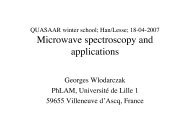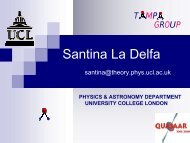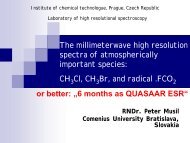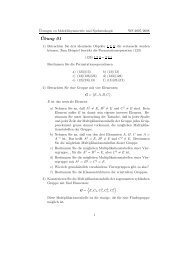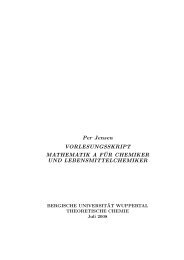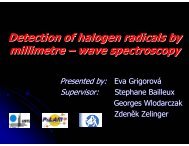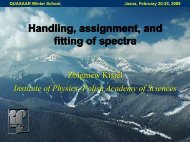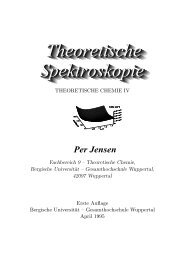202 Poster session, J39Rotational analysis of the E 1 Π – A 1 Π system of AlHW. Szajna 1 , R. Hakalla 2 , M. Zachwieja 3 ,I. Piotrowska 4 , M. Ostrowska-Kopeć 5 , P. Kolek 6 , R. Kępa 71,2,3,4,5,6,7 Atomic and Molecular <strong>Ph</strong>ysics Laboratory, Institute of <strong>Ph</strong>ysics,University of Rzeszów, 35-310 Rzeszów, POLAND1 szajna@univ.rzeszow.pl, 2 hakalla@univ.rzeszow.pl, 3 zachwiej@univ.rzeszow.pl,4 ipiotrowska@if.univ.rzeszow.pl, 5 mostrow@univ.rzeszow.pl,6 kolek@if.univ.rzeszow.pl, 7 krepa@univ.rzeszow.pl,Szajna W.Hakalla R.Zachwieja M.Piotrowska I.Ostrowska-Kopec M.Kolek P.Kepa R.The emission spectrum of the E 1 Π – A 1 Π system of the AlH molecule wasreinvestigated in the spectral region of about 29 000 cm -1 by using a high accuracydispersive optical spectroscopy. The AlH molecules were formed and excited in analuminium hollow-cathode lamp with two anodes, filled with a mixture of Ne buffer gasand a trace of NH 3 . The emission from the discharge was observed with a plane gratingspectrograph and recorded by a photomultiplier tube. The full rotational structure of the0-0 band was precisely measured end rotationally analyzed. The new data wereelaborated with help of recent A 1 Π state parameters reported by Szajna et al. 1 For theE 1 Π, υ = 0 state a considerable irregularities of the Λ-doubling have been observed. Themost reasonably explanation for this anomaly is perturbing of the e component of theE 1 Π state by the lying above and unobserved so far 1 Σ + state, as it was suggested byJohns 2 . Simultaneously, the f component of the E state was observed to be quite regularup to the observed rotational level. For the reason mentioned above the individual bandfit was done by means of the least-squares method suggested by Curl and Dane 3 andWatson 4 . In the linear upper E 1 Π, υ = 0 state model the terms values served as the fittedparameters, while the lower state A 1 Π, υ = 0, was represented by the effectiveHamiltonian proposed by Brown et al. 5 In this way precise values of the rotational termsof E 1 Π, υ = 0 state were obtained. Also main rotational constants for the f component ofE 1 Π, υ = 0 state were calculated from usual Hamiltonian method 5 .Fig. 1: Part of the rotational structure of the 0-0 band of the E 1 Π – A 1 Π system of AlH.References[1] W. Szajna, M. Zchiwieja, R. Hakalla, R. Kępa, Acta <strong>Ph</strong>ys. Pol. A, 120, 417, 2011.[2] A. Lagerquist, L. E. Lundh, H. Neuhaus, <strong>Ph</strong>ys. Scripta, 1, 261, 1970.[3] R.F. Curl, C.B. Dane, J. Mol. Spectrosc., 128, 406, 1988.[4] J.K.G. Watson, J. Mol. Spectrosc., 138, 302, 1989.[5] J.M. Brown, E.A. Colbourn, J.K.G. Watson, F.D. Wayne, J. Mol. Spectrosc., 74,294, 1979.
Poster session, J40 203The CW-CRDS spectra of the 16 O 18 O 16 O ozone isotopologue near 6200cm -1 : experiment and analysis of three new bandsDidier Mondelain 1 , Samir Kassi 1 , Alain Campargue 1 , Alain Barbe 2 , EvgeniyaStarikova 2,3 , Marie-Renée De Backer 2 , Vladimir Tyuterev 21 LI<strong>Ph</strong>y, Université Grenoble, France, E-mails: didier.mondelain@ujf-grenoble.fr,samir.kassi@ujf-grenoble.fr, alain.campargue@ujf-grenoble.fr; 2 Université de Reims,France, E-mails: alain.barbe@univ-reims.fr, mr.debacker@univ-reims.fr,vladimir.tyuterev@univ-reims.fr; 3 LTS, V.E. Zuev Institute of Atmospheric Optics,Russia, E-mail: starikova_e@iao.ruMondelain D.Kassi S.Campargue A.Barbe A.De BackerStarikova E.Tyuterev V.The absorption spectra of 16 O 3 , 18 O 3 and two 18 O enriched ozone samples were recordedby CW-Cavity Ring Down Spectroscopy in the 6170-6340 cm -1 spectral range [1, 2 andrefs therein]. The ozone generation from a mixture of 16 O 2 and 18 O 2 leads to theproduction of the six isotopic species. In order to discriminate between their variousforms, two 16 O 2 / 18 O 2 mixtures with 75/25 and 40/60 relative abundance were used. Bylinear combination of the spectra of the two 18 O enriched ozone mixture with those of16 O 3 [3, 4] and 18 O 3 [5], it was possible to separate the contribution of 16 O 16 O 18 O and16 O 18 O 16 O on one side and that of 18 O 18 O 16 O and 18 O 16 O 18 O on the other side.In the 6200 cm -1 region, three relatively intense A-type bands were analysed in 16 O 3[3, 4] and18 O 3 [5], labeled 2ν 2 +5ν 3 , 5ν 1 +ν 3 and 2ν 1 +2ν 2 +3ν 3 (or ν 1 +ν 2 +5ν 3 ),respectively. More recently, these three bands have been analyzed for the C 16 S O 16 O 18 Oisotopologue [6].In this work, we report the analysis of the corresponding bands of the 16 O 18 O 16 O C 2Visotopologue, located at 6151.381, 6182.305 and 6225.250 cm -1 . Energy levels,effective Hamiltonian and transition moment parameters, statistics of the fits for linepositions and intensities, and examples of comparisons between observed and simulatedspectra will be presented. Comparisons between band centres and rotational constantsderived from the experiment with very recent theoretical predictions from a newpotential function [7] will be discussed.References[1] M.R. De Backer-Barilly, A. Barbe et al, J. Mol. Struct. 780, 225, 2006[2] J. Morville, D. Romanini, A. A. Kachanov, Appl. <strong>Ph</strong>ys. 78, 465, 2004[3] A. Barbe, M.R. De Backer-Barilly et al, J. Mol. Spectrosc. 242, 156, 2007[4] A. Barbe, M.R. De Backer-Barilly, S. Kassi et al, J. Mol. Spectrosc. 246, 22, 2007[5] A. Campargue, A.W. Liu, S. Kassi et al, J. Mol. Spectrosc. 255, 75, 2009[6] D. Mondelain, S. Kassi, A. Campargue, A. Barbe et al, J. <strong>Ph</strong>ys. B, 2012, submitted[7] Vl. G. Tyuterev, R.Kochanov et al, 2012, in preparation1
- Page 1 and 2:
Book of abstractsof the 22 th Inter
- Page 3 and 4:
CommitteesLocal Organizing committe
- Page 5:
Table of contentProgram of sessions
- Page 8 and 9:
8 Program of sessionsInvited Lectur
- Page 10 and 11:
10 Program of sessionsD6 Tasinato N
- Page 12 and 13:
12 Program of sessionsD23 Underwood
- Page 14 and 15:
14 Program of sessionsD43 Kirkpatri
- Page 16:
16 Program of sessionsG5 Ebert V. 1
- Page 20 and 21:
20 Program of sessionsH36 Vogt N.,
- Page 22 and 23:
22 Program of sessionsJ8 Tudorie M.
- Page 24 and 25:
24 Program of sessionsJ26 Osman O.,
- Page 26 and 27:
26 Program of sessionsIoannes Marcu
- Page 28 and 29:
28 Program of sessionsContributed L
- Page 31 and 32:
Invited LecturesASeptember 4, Tuesd
- Page 33:
Invited Lectures, A2 33Ultra sensit
- Page 36 and 37:
36 Contributed Lectures, B1Chirped-
- Page 38 and 39:
38 Contributed Lectures, B3Chirped
- Page 40 and 41:
40 Contributed Lectures, B5Laborato
- Page 43 and 44:
Invited LecturesCSeptember 4, Tuesd
- Page 45:
Invited Lectures, C2 45Chiral recog
- Page 48 and 49:
48 Poster session, D1Spectroscopic
- Page 50 and 51:
50 Poster session, D3Ab-initio norm
- Page 52 and 53:
52 Poster session, D5The 2 and 4
- Page 54 and 55:
54 Poster session, D7IR spectroscop
- Page 56 and 57:
56 Poster session, D9The stretching
- Page 58 and 59:
58 Poster session, D11Rotationally-
- Page 60 and 61:
60 Poster session, D13Frequency ana
- Page 62 and 63:
62 Poster session, D15High-L atomic
- Page 64 and 65:
64 Poster session, D17High-Resoluti
- Page 66 and 67:
66 Poster session, D19Frequency-com
- Page 68 and 69:
68 Poster session, D21Variational c
- Page 70 and 71:
70 Poster session, D23Variationally
- Page 72 and 73:
72 Poster session, D25MOGADOC - A D
- Page 74 and 75:
74 Poster session, D27Theoretical I
- Page 76 and 77:
76 Poster session, D29Spectroscopy
- Page 78 and 79:
78 Poster session, D31Coriolis Anal
- Page 80 and 81:
80 Poster session, D33Symmetric gro
- Page 82 and 83:
82 Poster session, D35Dissociative
- Page 84 and 85:
84 Poster session, D37Absorption sp
- Page 86 and 87:
86 Poster session, D39Low-energy vi
- Page 88 and 89:
88 Poster session, D41New progress
- Page 90 and 91:
90 Poster session, D43High Resoluti
- Page 93 and 94:
Invited LecturesESeptember 5, Wedne
- Page 95:
Invited Lectures, E2 95Theoretical
- Page 98 and 99:
98 Contributed Lectures, F1On the r
- Page 100 and 101:
100 Contributed Lectures, F3High Re
- Page 102 and 103:
102 Contributed Lectures, F5Large A
- Page 105 and 106:
Contributed LecturesGSeptember 5, W
- Page 107 and 108:
Contributed Lectures, G2 107Inversi
- Page 109 and 110:
Contributed Lectures, G4 109Spontan
- Page 111:
Contributed Lectures, G6 111High te
- Page 114 and 115:
114 Poster session, H1Computation o
- Page 116 and 117:
116 Poster session, H3Rotationally-
- Page 118 and 119:
118 Poster session, H5The Rotationa
- Page 120 and 121:
120 Poster session, H7Laser-Induced
- Page 122 and 123:
122 Poster session, H9High resoluti
- Page 124 and 125:
124 Poster session, H11Structure, U
- Page 126 and 127:
126 Poster session, H13From succini
- Page 128 and 129:
128 Poster session, H15On the “Ex
- Page 130 and 131:
130 Poster session, H17Hyperfine sp
- Page 132 and 133:
132 Poster session, H19The first ro
- Page 134 and 135:
134 Poster session, H21High Resolut
- Page 136 and 137:
136 Poster session, H23Spectroscopy
- Page 138 and 139:
138 Poster session, H25New investig
- Page 140 and 141:
140 Poster session, H27Submillimetr
- Page 142 and 143:
142 Poster session, H29First analys
- Page 144 and 145:
144 Poster session, H31High-Resolut
- Page 146 and 147:
146 Poster session, H33Rotational s
- Page 148 and 149:
148 Poster session, H35New assignme
- Page 150 and 151:
150 Poster session, H37Hydrogen Sul
- Page 152 and 153: 152 Poster session, H39New Millimet
- Page 154 and 155: 154 Poster session, H41First analys
- Page 156 and 157: 156 Poster session, H43High-Resolut
- Page 159 and 160: Invited LecturesISeptember 6, Thurs
- Page 161: Invited Lectures, I2 161New Telesco
- Page 164 and 165: 164 Poster session, J1Synthesis, Ch
- Page 166 and 167: 166 Poster session, J3Radio Search
- Page 168 and 169: 168 Poster session, J5N 2 -, O 2 -
- Page 170 and 171: 170 Poster session, J7Quantum-class
- Page 172 and 173: 172 Poster session, J9On the ECS fo
- Page 174 and 175: 174 Poster session, J11Measurement
- Page 176 and 177: 176 Poster session, J13Review of th
- Page 178 and 179: 178 Poster session, J15Halogen bond
- Page 180 and 181: 180 Poster session, J17Multispectru
- Page 182 and 183: 182 Poster session, J19Potential en
- Page 184 and 185: 184 Poster session, J21The Study of
- Page 186 and 187: 186 Poster session, J23Pollutants m
- Page 188 and 189: 188 Poster session, J25Preparation
- Page 190 and 191: 190 Poster session, J27Databases of
- Page 192 and 193: 192 Poster session, J29Ozone FTS sp
- Page 194 and 195: 194 Poster session, J31Joint Ro-Vib
- Page 196 and 197: 196 Poster session, J33Water vapor
- Page 198 and 199: 198 Poster session, J35Line positio
- Page 200 and 201: 200 Poster session, J37Hyperfine St
- Page 204 and 205: 204 Poster session, J41Tissue Bondi
- Page 207 and 208: Ioannes Marcus MarciKSeptember 6, T
- Page 209 and 210: Invited LecturesLSeptember 7, Frida
- Page 211: Invited Lectures, L2 211Collision-I
- Page 214 and 215: 214 Contributed Lectures, M1Flexibl
- Page 216 and 217: 216 Contributed Lectures, M3Continu
- Page 218 and 219: 218 Contributed Lectures, M5High-pr
- Page 221 and 222: Contributed LecturesNSeptember 8, S
- Page 223 and 224: Contributed Lectures, N2 223Two- di
- Page 225 and 226: Contributed Lectures, N4 225Spectro
- Page 227 and 228: Contributed Lectures, N6 227Spin-or
- Page 229 and 230: Contributed Lectures, N8 229Quantum
- Page 231: Contributed Lectures, N10 231Line m
- Page 234 and 235: 234 Author indexAAbdelghany A. —
- Page 236 and 237: 236 Author indexChoi B. — D33Ciur
- Page 238 and 239: 238 Author indexGGambi A. — D6Gä
- Page 240 and 241: 240 Author indexKhelkhal M. — D29
- Page 242 and 243: 242 Author indexMartin M.A. — D31
- Page 244 and 245: 244 Author indexPolyansky O. — D2
- Page 246 and 247: 246 Author indexSzajna W. — H29,
- Page 248 and 249: 248 Author indexZamotaeva V.A. —
- Page 250 and 251: 250 EmailsAbdelghany A.Abdelghany A
- Page 252 and 253:
252 EmailsGuarnieri A.ag@tf.uni-kie
- Page 254 and 255:
254 EmailsMichaut X.Xavier.Michaut@
- Page 256 and 257:
256 EmailsTyuterev Vl.G.vladimir.ti
- Page 258 and 259:
FT-IR spectrometerIFS 125HROutstand
- Page 260 and 261:
32nd International Symposium on Fre
- Page 262 and 263:
Some more information
- Page 264:
Addresses:Conference Site: National




